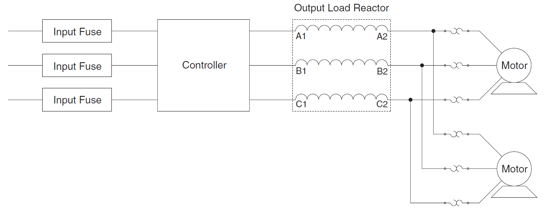
There are many reasons why lead length between Variable Frequency Drives (VFDs) and motors are excessive. VFDs are sensitive electronic equipment and must be installed in clean and dry environments, forcing long distances between motor control rooms and the motors that they control. Also, some applications such as conveyors often use a single drive to operate multiple motors on the line. The length of the conveyor dictates the longest distance between drive and motor. With these constraints, output load reactors are the best answer in drive solutions to preventing motor failure.
Identifying Motor Stress Points
Motors controlled by VFDs installed at long distances often fail due to high voltage induced insulation breakdown. VFDs use insulated gate bipolar transistors (IGBTs). These devices offer many advantages and improve the control of AC motors, but there are some tradeoffs. Some IGBT characteristics, particularly their fast switching capability, combined with long lead lengths between the drive and motor, can shorten motor life.
IGBTs let drives turn voltage on and off at a very high frequency: 4,000 to 16,000 times a second. This means the voltage rise time is short and usually less than a few microseconds. These short rise times combined with long lead lengths between the drive and motor can produce voltage reflections, also called reflected waves, that have high peak voltages. If the voltages are large enough, they will produce stresses in the motor insulation.
Shorter voltage rise time and longer motor lead length produce higher amplitudes of the reflected wave. The voltage can reach two times or more than the DC bus voltage. Therefore, if a drive has a 650 Vdc bus (normal for 480V input), voltages at the motor may reach 1,300 or higher, enough to cause some motors to fail.
Using Output Load Reactors to Close the Gap
Most VFD manufacturers recommend a maximum distance between drive and motor. Most distances are between 100 to 300 ft. Installing output reactors between the drive output and the motor reduces the rate of voltage rise (increases the voltage rise time). This limits the reflected wave amplitude and extends the allowable distance for motor cables.
The general “rule of thumb” is that an output reactor should be used if the motor wiring extends over 100 ft., but this value can vary depending on the motor. For example, a motor may not need an output load reactor if the motor meets the NEMA MG-1 Part 31 standard, which specifies that insulation for low-voltage (< 600V) inverter duty motors should be designed to withstand an upper limit of 3.1 times the motor’s line-line voltage rating. These motors can be used without additional filters or load reactors, provided that voltage overshoots do not exceed the upper limit at the motor terminals.
For any motor, if the distance is between 300 to 500 ft., a load reactor should be used. If the distance is over 500 ft. then a special type of filter called a dV/dT filter (low-pass filter) should be used.
Adding an Output Load Reactor
Load reactors are connected in a series between the VFD and motor and should be mounted as close to drive as possible.

For applications such as conveyors involving more than one motor connected to single drive, a single output reactor should be used between VFDs and motors. Note that each motor requires a separate thermal overload for proper protection. The reactor should be sized based on total motor load. Load reactors are connected in a series between the VFD and motor and should be mounted as close to drive as possible.

Conclusion
While the sensitivity of VFD equipment requires large gaps between motors and controls, output load reactors make it possible to avoid motor failure as a result of the distance. Select and install output load reactors based on the distance your wires have to travel between your motors and the VFDs. Taking the time to properly integrate output load reactors into the system can prevent motor failure while respecting the constraints of VFD equipment. One of Premier Automation's experienced engineers can walk you through the process of installing output load reactors to keep your motors humming.



